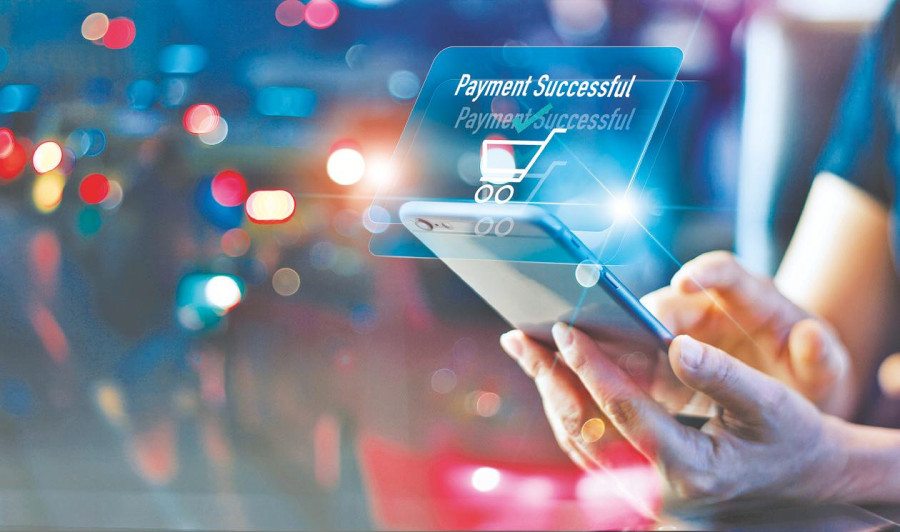Money
How the pandemic helped accelerate shift to digital payments
Electronic transactions crossed Rs6 trillion in the final month of the last fiscal year.
Krishana Prasain
Digital payments swelled by 18 percent year-on-year in the final month of the last fiscal year to cross the Rs6 trillion mark, which experts say is a sign of electronic transactions gaining traction.
According to the central bank, digital payments for goods and services during the period mid-June to mid-July 2022 amounted to Rs6.22 trillion.
In the previous fiscal year 2020-21, digital payments during the same one-month period totalled Rs5.26 trillion, almost double the Rs2.76 trillion in fiscal 2019-20.
Transactions normally surge during the last month of the financial year as businesses and individuals rush to clear their bills and taxes.
The rise of the digital economy has been one of the most significant fallouts of the Covid pandemic, which changed the way Nepalis make payments as they were forced to remain indoors, experts said.
Nepal Rastra Bank said the number of transactions soared to 71.42 million during the review period, up from 48.54 million transactions during the period mid-June to mid-July 2021.
“First, the Covid-19 pandemic boosted payments through digital means. Now, the central bank has launched various policies to promote digital transactions, and the result is becoming visible,” said Guru Prasad Poudel, executive director of Nepal Rastra Bank.
Payments made through the quick response (QR) system have grown steeply.
According to Nepal Rastra Bank, 4.28 million transactions were made through the QR payments system, with a total value of Rs14.52 billion in the final month of the last fiscal year.
“The central bank has made clear provisions for wallet and internet banking. It has also eased the process for utility payments that has boosted demand for electronic payment systems across the country,” Poudel said.
"The central bank has established its own real-time settlement for retail payments."
A separate department was set up for the digital payment service in 2018.
Nepal Clearing House, a dedicated institution that is involved with digital payments, was also established to facilitate payment modes.
The central bank owns 10 percent of Nepal Clearing House while the rest of the stock is held by banks and financial institutions.
“We are seeing a sharp transformation among people from traditional payment modes to digital,” Poudel said.
The government’s Digital Nepal Framework 2019 concept also supports payments over the internet to create the ecosystem, he said.
The national payment switch started functioning in November last year after Nepal Clearing House obtained operation approval from Nepal Rastra Bank.
The payment gateway brings together banks and digital payment vendors allowing them to transfer money. As part of the first phase, 29 banks and financial institutions have been affiliated with the national payment switch.
“Our target is to complete the work on the national payment switch quickly,” Poudel said. "A delay has occurred, but the work is going on."
In the second phase, Nepal Clearing House will work on a national cards system; and in the third phase, all domestic electronic transactions will be routed through the national payment switch, as per the company.
Currently, domestic Visa and MasterCard transactions are switched through international payment gateways and are charged in dollars per transaction.
But with the implementation of the national payment switch, the card payment switch will be made inside the country which will reduce charges, and make transactions faster and more convenient, according to central bank officials.
Upendra Poudyal, chairman of Nabil Bank, said that digital literacy had boosted the number of electronic transactions.
"But still, users need to be made aware about making payments securely," Poudyal said. "Banks and financial institutions also need to verify their systems time and again."
A breakdown of the online payments shows that 81,817 transactions worth Rs4.34 trillion were made through real-time gross settlement during the period mid-June to mid-July of the last fiscal year. During the same period of the previous fiscal year, there were 59,655 transactions worth Rs3.1 trillion.
Real-time gross settlement or RTGS is an electronic form of funds transfer where the transmission takes place on a real-time basis.

After RTGS, interbank payments accounted for 1.32 million transactions worth Rs275.75 billion. During the same period in the previous fiscal year, there were 1.16 million payments worth Rs299 billion.
ConnectIPS accounted for 4.27 million transactions worth Rs369.22 billion, up from 3.2 million transactions worth Rs237.75 billion in the previous fiscal year.
Internet banking transactions accounted for 318,598 transactions with a total value of Rs15.63 billion. There were 329,523 transactions worth Rs13.83 billion previously.
Bankers say that due to the rise in mobile banking transactions, the number of internet banking transactions has dropped.
Mobile banking transactions amounted to 20.56 million, posting a total value of Rs163.25 billion in the review period, a sharp increase from 13.70 million transactions worth Rs73.72 billion in the previous fiscal year.
The wallet system saw 16.20 million transactions with a total value of Rs17.75 billion, up from 12.51 million transactions with a total value of Rs12.79 billion previously.
The rising number of smartphone users and increasing internet penetration has boosted digital payments overall.
According to the management information system report of the Nepal Telecommunications Authority, there were 38.13 million internet subscribers in the country as of mid-June 2022, with broadband penetration reaching 130.63 percent of the total population.
According to Nepal Rastra Bank, 1.17 million points of sales transactions worth Rs5.18 billion were made in a single month from mid-June to mid-July. There were 635,599 transactions worth Rs2.66 billion in the same period of the previous fiscal year.
Nepalis made 68,944 e-commerce transactions worth Rs504 million using cards.
“Nepal aspires to become a cashless society and will gradually move to achieve this goal. It may take years or decades,” said Poudyal. “But a complete cashless society is not possible because there will still be people who feel safe only when they have cash in their hands.”




 9.68°C Kathmandu
9.68°C Kathmandu















